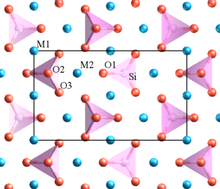User:Denniskuipers/Peridot Sandbox
Peridot[edit]
Peridot (/ˈpɛrɪdɒt/ or /ˈpɛrɪdoʊ/) (sometimes called chrysolite) is gem-quality olivine and a silicate mineral with the formula of (Mg, Fe)2SiO4. As peridot is a magnesium-rich variety of olivine (forsterite), the formula approaches Mg2SiO4. Its green color is dependent on the iron contents within the structure of the gem. Peridot occurs in silica-deficient rocks such a volcanic basalt as well as in pallasitic meteorites.
Peridot is one of only two gems observed to be formed not in the Earth’s crust, but in molten rock of the upper mantle. Gem-quality peridot is rare to find on Earths surface due to its susceptibility to weathering during transportation from deep within the mantle to the surface. In the Middle Ages, the gemstone was considered a stone that could provide healing powers, curing depression and opening the heart. Peridot is the birthstone for the month of August and the 16 year wedding anniversary gemstone.
Etymology[edit]
Appearance[edit]
Mineral Properties[edit]
Crystal structure[edit]

The molecular structure of peridot consist of isomorphic olivine, silicate, magnesium and iron in an orthorhombic crystal system. In an alternative view, the atomic structure can be described as a hexagonal, close-packed array of oxygen ions with half of the octahedral sites occupied with magnesium or iron ions and one-eighth of the tetrahedral sites occupied by silicon ions.
Surface property[edit]
Oxidation of peridot does not occur at natural surface temperature and pressure, but begins to occur slowly at 600°C with rates increasing with temperature[1]. The oxidation of the olivine occurs by initial breakdown of the fayalite component, and subsequent reaction with the forsterite component, to give magnetite and orthopyroxene.
Occurrences[edit]
Geologically[edit]
In meteorites[edit]

Peridot crystals have been collected from some pallasite meteorites. These gems are given the name Moldavite to differentiate their origin. The most commonly studied pallasitic peridot belongs to the Indonesian Jeppara meteorite, but others exist such as the Brenham, Esquel, Fukang, and Imilac meteorites.[2]
Gemology[edit]
Refractive index readings of faceted gems contain indices α = 1.653, β = 1.670, and γ = 1.689 with a corresponding bi-axial birefringence of 0.036. Study of Chinese peridot gem samples determined the specific gravity hydro-statically to be 3.36. The visible-light spectroscopy of the same Chinese peridot samples showed light bands between 493.0 and 481.0 nm, the strongest absorption at 492.0 nm.[3]
Inclusions are common in peridot crystals but the variety depend on the location it is found at. Stones from Pakistan contain silk and rod like inclusions as well as black chromite crystal inclusions surrounded bi-circular cleavage discs resembling lily pads, and finger print inclusions. Brown Mica flakes are more evident in Arizona gems.[3]
Cultural History[edit]
Peridot has been prized since the earliest civilizations for its protective powers to drive away fears and nightmares. It's believed to carry the gift of inner radiance, sharpening the mind and opening it to new levels of awareness and growth, helping one to recognize and realize one’s destiny and spiritual purpose.
Ancient Egyptians believed that Peridot was sent to Earth by the explosion of a star and carried its healing powers. Peridot is the national gem of Egypt known to locals as the Gem of the Sun.
Peridot is sometimes mistaken for emeralds and other green gems. Notable gemologist George Frederick Kunz discussed the confusion between emeralds and peridot in many church treasures, notably the "Three Magi" treasure in the Dom of Cologne, Germany.
Peridot olivine is the birthstone for the month of August and the 16th wedding anniversary gemstone.
References[edit]
- ^ Knafelc, Joseph; Filiberto, Justin; Ferré, Eric C.; Conder, James A.; Costello, Lacey; Crandall, Jake R.; Dyar, M. Darby; Friedman, Sarah A.; Hummer, Daniel R.; Schwenzer, Susanne P. (2019-05-01). "The effect of oxidation on the mineralogy and magnetic properties of olivine". American Mineralogist. 104 (5): 694–702. doi:10.2138/am-2019-6829. ISSN 0003-004X.
- ^ Leelawatanasuk, Thanong; Atichat, Wilawan; Thye Sun, Tay; Sriprasert, Boontawee; Jakkawanvibul, Jirapit (2014). "Some Characteristics of Taaffeite from Myanmar". The Journal of Gemmology. 34 (2): 144–148. doi:10.15506/jog.2014.34.2.144. ISSN 1355-4565.
- ^ a b Koivula, John I.; Fryer, C. W. (1986-04-01). "The Gemological Characteristics of Chinese Peridot". Gems & Gemology. 22 (1): 38–40. doi:10.5741/GEMS.22.1.38. ISSN 0016-626X.
